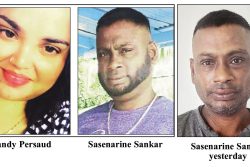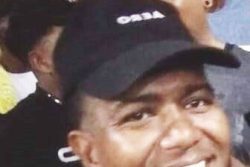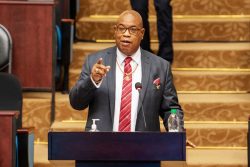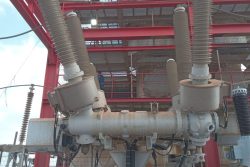The image of a man burying bones in the sand was still on my mind as I engaged in the long and arduous journey out of Lindo Creek. I was thirsty and exhausted and even worse my joints were aching and cramp was stepping in. I didn’t want to stop but I felt that I needed to. “We’re three minutes away,” my colleague said as we continued. I proceeded slowly growing increasingly tired with every step.
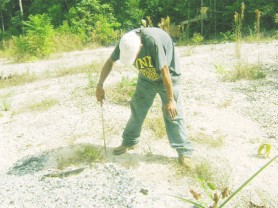
Here I was in “bush territory” on a return trek from Camp Lindo, the site where eight miners were murdered about a year ago. Dax Arokium, his uncle Cedric, Compton Speirs, Horace Drakes, Clifton Wong, Lancelot Lee, Bonny Harry and Nigel Torres were working at the site a year ago. My colleague (who for some strange reason has asked to remain anonymous) and I were part of a team which visited the camp site, a few weeks ago. This group, which consisted mainly of close friends of the deceased miners, had undertaken the trip in an attempt to find closure. This was the first time they had journeyed to this location after the bodies were found.
I had successfully, if not altogether uneventfully, trekked to Camp Lindo. The journey was challenging. Navigating fallen trees, going up an incline and walking on narrow half-rotted logs which served as bridges over streams were not my idea of fun. Traversing this area required certain skills, some of which I did not possess. This resulted in a few slips and falls along the way, but fortunately I only suffered minor injuries, mostly to my ego and pride.
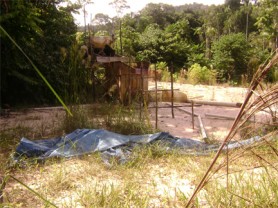
The camp was not quite what I had expected. Although it would be difficult to say what exactly were my expectations. I have to admit that had it not been for the scattered yellow “police” tape, I would not have guessed that it was where the brutal killings occurred just about a year ago. The site looked just as if the miners had gone off for a sojourn and would return anytime. The equipment was still there; set up and seemingly operational. The lavador, the engines, the pump and the other pieces of machinery were spread across different sections of the camp, displaying that serious work went on there.
The scattered pots, utensils and clothing on the site showed another side of life there, indicating that this was once the dwelling place of a group of people. However, it was the ashes, the charred upper portion of a pair of long boots and the burnt fragments of blue tarpaulin that told the real story. It wasn’t quite a feeling of eeriness, but there was certainly the sense that something “big” had ‘gone down’ there.
But undoubtedly seeing what appeared to be the remains of human bones was what stood out. Now this, I can honestly say, was not what I had anticipated. And from the reactions of the rest of the party, no one else had expected that either. These bones were scattered among gravel and the ashes, and some were fairly sizeable. This certainly did not look like a site that had been thoroughly examined by any forensic team.
The reaction by one member of the party Kerwin (not his real name) stands out in my memory. He was clearly hurt and even angry that the bones of his friends were left exposed. He was the one who dared to touch the bones when everyone else was reluctant to. And I guess that is why burying the bones was a priority for him. He seemed closest to Dax Arokium, who he referred to as “Tall Man” and whose name he called as he buried the bones. I did not know Dax or any of the other miners but I did appreciate the great emotion of the moment. The image of Kerwin with the cutlass burying the bones in the sand will remain in my memory for a very long time.
The experiences at the site rolled around in my head as we travelled back to the UNAMCO road. “Never again,” I kept saying to myself as I slowly made my way forward along the trail. I clutched my bag, grateful that it had been found. The strap had burst while I was navigating some of the fallen trees and had detached itself from my shoulder without me realizing it. Valuable equipment and documents were inside. So my colleague and I turned back to look for it, while the rest of the party continued their journey. That proved to be a mistake since we got quite lost. However, we ‘found’ them again before the deep panic set in.
When we finally reached the rest of the party, I threw myself on the ground taking the breather, I had wanted approximately five minutes earlier.
“Ya’ll men gah belly,” I said.
They smiled. Then one of them said to me, “Man dat is nothing, we does have to climb mountain and suh.”
I was just too tired to even properly analyse his statement.
Solomon (not his real name), the driver of the cruiser, then called out to me with a wry smile and showed me the front left tyre of the vehicle. The sight was not encouraging. The problematic front tyre had practically disintegrated. And he did not have a spare, as we had unfortunately discovered hours earlier on our journey to the site. This trip was quickly going from bad to worse.
Soon after, Solomon signalled that he was ready to begin the return trip. While the rest of the party sat in the tray of the vehicle, I sat in the cab next to Solomon. I did this mainly because there was no space in the tray, but I was also greatly influenced by my extreme tiredness.
Solomon and I are friends now and I discovered that my presence was welcomed. I enquired as to what was the plan. He disclosed that we would go as far as we could, but explained that his goal was to get to Ituni. “When we reach there we can get some help,” he said.
Hours earlier I had realized how unbelievably carefree this driver was. We were in this predicament primarily because he had forgotten his spare wheel. We were stranded on the trail for about three hours after the left front wheel developed a puncture. So while some members of our party had to walk to Kwakwani to get the tyre patched Solomon, my colleague and I remained.
Words of wisdom from ‘Solomon’
Being stranded on the trail left us with very little to do other than interact with each other. And well for me, it was a chance to speak with our wise driver Solomon.
It was obvious that he was candid, carefree and even crude. Solomon is a wealthy businessman who owns a mining operation in the North West District. He now has his eyes set on venturing into diamond mining in the vicinity of Lindo Creek. His purpose for travelling there was to examine the feasibility of it.
Now 53, he said he had worked hard and reaped the rewards of years of hard work. According to him he was now living for himself, and intended to enjoy his life doing exactly what he wanted.
This ideology clearly informed his choices. He is a heavy smoker; lighting up a cigarette every 12 to 15 minutes, and this is no exaggeration. According to him, “it is just my thing” and that there is no particular satisfaction he gets out of this act: “I’ve been doing it for years,” he explained.
His language is colourful and encapsulates part of his crude nature. Almost every sentence he utters contains multiple expletives, a fact which he candidly acknowledges: “I can’t help it” he says, “this is the industrial language. I became corrupted over the years.”
He loves women and emphasizes the importance of having a good woman in your life. And it was on these grounds that he encouraged me and my colleague to get married.
“Y’all should get married,” he said. “Marriage is nice.” He then disclosed that he is now on his third marriage.
The first lasted a few years before his wife left him and the second only a few months before he decided to call it quits.
He has been married to his current wife for over 20 years; and he says that it has been a good marriage. But even so, he advocates the importance of keeping one’s options open and being willing to meet the needs of different women. He even found a religious twist to support this idea, “If the sister has a need, you must meet it,” he says.
He also shared his views on local and international politics, life, death, religion and much more. I didn’t agree with most of what he said, but at least this was entertaining conversation.
As we continued on our journey to Ituni on three tyres, I was sitting in the tray experiencing a rough journey. The trip was rough not only because the trail was in a terrible condition but also because of Solomon’s horrific driving. He drove as if all the tyres were in perfect working order. And, as expected, when warned about his driving, he uttered his customary expletives and continued along recklessly. Not surprisingly, we had to disembark twice and push the vehicle after it got stuck in a hole or in sand. Matters were made even worse when the vehicle started to overheat. At one point I began to feel that we would not even make it to Ituni.
After what seemed like an eternity, we arrived in Ituni. It was about 9.30 pm and it soon became clear that we would have to overnight here. There was no quick remedy for our vehicle woes. By the time we had arrived, the front wheel had totally disintegrated to the point that we had been driving on the rim alone for several hours, while the left rear tyre was also decompressed.
My colleague and I both realized that sleeping in the vehicle was not a realistic option. Solomon had already claimed the back and another of our party made the front seats his bed. We needed to find somewhere to sleep. After some enquiries we were told that there weren’t any guesthouses in the community.
Just when we had resigned ourselves to a night of no sleep, two women passed by and directed us to a guesthouse.
Fortunately, after being told initially that there was no room, we were eventually able to get the last two available beds. I had initially felt great remorse that the two of us had left the rest of the party behind, but I justified the act by thinking that we had been left with no choice. During the night it rained. I was most grateful that I had shelter over my head when it did.
Next morning, with no prospect of the vehicle being repaired anytime soon we made our way to Georgetown by bus, the final leg of a physically demanding trip.
I had gone to Camp Lindo knowing that there was great mystery surrounding what had happened at this site just a year ago. My visit to the site left me with questions of my own, some of which may never be adequately answered. But now more than ever there is a yearning to know the full details of what actually happened at Camp Lindo a year ago.

